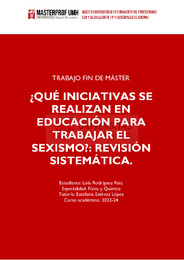Please use this identifier to cite or link to this item:
https://hdl.handle.net/11000/32999
¿Qué iniciativas se realizan en educación para trabajar el sexismo?: Revisión sistemática
Title:
¿Qué iniciativas se realizan en educación para trabajar el sexismo?: Revisión sistemática |
Authors:
Rodríguez Ruiz, Lola  |
Tutor:
ESTÉVEZ, ESTEFANÍA |
Editor:
Universidad Miguel Hernández |
Department:
Departamentos de la UMH::Psicología de la Salud |
Issue Date:
2024 |
URI:
https://hdl.handle.net/11000/32999 |
Abstract:
Antecedentes: La lucha por la igualdad de género requiere de diferentes estrategias que aborden las raíces socioculturales de las actitudes sexistas. En este contexto, la educación juega un papel crucial en la formación de valores y comportamientos igualitarios en las nuevas generaciones
Objetivos: Idetificar las diferentes iniciativas que se realizan en educación para disminuir el sexismo en adolescentes.
Método: Se ha realizado una revisión sistemática siguiendo las directrices del método PRISMA.
Resultados: En las intervenciones estudiades se observa una disminución del sexismo en el alumnado tras las actividades. Sin embargo, estas estrategias presentan limitaciones, y en ocasiones la muestra no es muy elevada.
Conclusiones: La promoción de la igualdad de género en adolescentes requiere de un enfoque integral que incluya la formación de un consenso sobre la transmisión de valores, la capacitación docente y la investigación continua. Estas acciones son esenciales para crear entornos educativos y sociales que favorezcan el crecimiento de las nuevas generaciones en un marco de respeto e igualdad.
Background: Gender equality requires different strategies that address the sociocultural origins of sexist attitudes. In this context, education is crucial in forming egalitarian values and behaviors in the new generations.
Aims: The main objective was to identify the different initiatives carried out in secondary schools to reduce sexism in adolescents.
Method: A systematic review was carried out following the guidelines of the PRISMA method.
Results: In the different interventions studied, a decrease in sexism in secondary school students was observed after the proposed activities. However, these strategies have certain limitations, therefore, in some cases, the number of people involved is quite small.
Conclusions: Promoting gender equality in adolescents requires a comprehensive approach that includes consensus building on the transmission of values, teacher training, and ongoing research. These actions are essential to creating educational and social environments that allow the growth of new generations within a framework of respect and equality.
|
Notes:
Especialidad: Física y Química |
Keywords/Subjects:
Igualdad de género
Educación |
Type of document:
info:eu-repo/semantics/masterThesis |
Access rights:
info:eu-repo/semantics/openAccess |
Appears in Collections:
TFM - M.U Formación del Profesorado ESO y Bachillerato, FP y Enseñanzas de Idiomas
|
Items in DSpace are protected by copyright, with all rights reserved, unless otherwise indicated.
.png)
